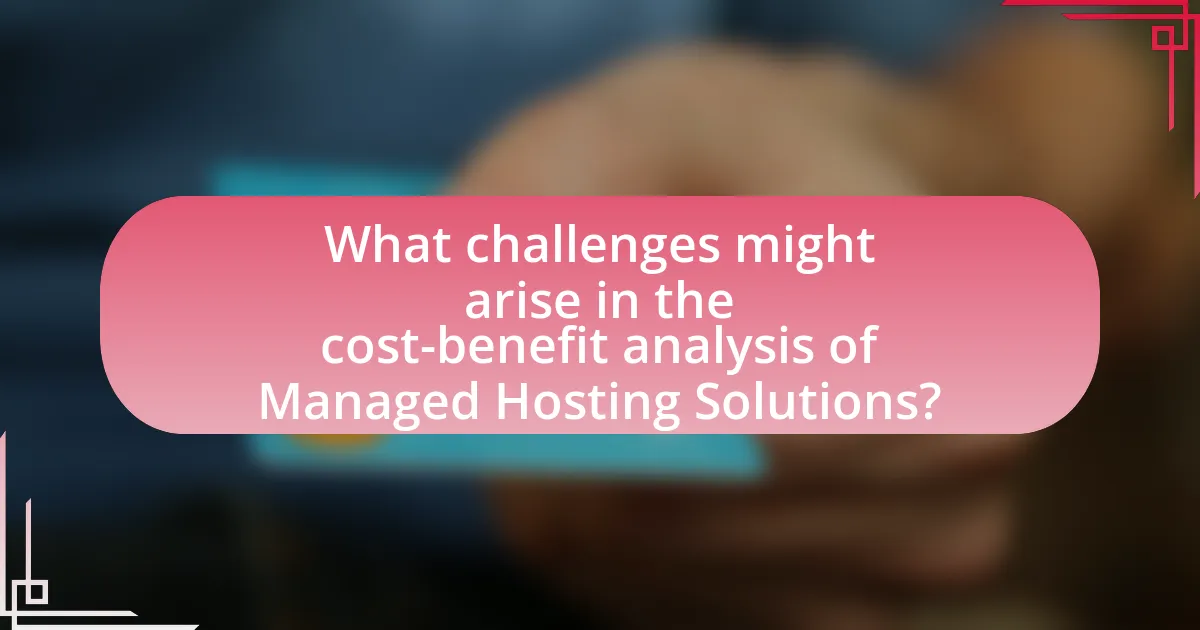The main entity of the article is the cost-benefit analysis of managed hosting solutions. The article examines how the benefits of managed hosting, such as enhanced security, improved performance, and expert support, often outweigh the higher costs associated with these services. It details the key components of costs, the advantages of managed hosting, and the importance of conducting a thorough cost-benefit analysis for informed decision-making. Additionally, it addresses potential challenges and best practices in evaluating managed hosting solutions, emphasizing the significance of stakeholder input and regular reviews to optimize resource allocation and align with strategic goals.

What is the Cost-Benefit Analysis of Managed Hosting Solutions?
The cost-benefit analysis of managed hosting solutions reveals that the benefits often outweigh the costs, particularly for businesses seeking reliability and support. Managed hosting typically incurs higher upfront costs compared to shared hosting, with prices ranging from $100 to $1,000 per month depending on the service level. However, the advantages include enhanced security, dedicated resources, and expert technical support, which can lead to reduced downtime and improved performance. For instance, a study by HostingAdvice found that businesses using managed hosting experienced 99.99% uptime, significantly minimizing revenue loss due to outages. Additionally, the reduction in in-house IT management costs and the ability to scale resources efficiently further justify the investment in managed hosting solutions.
How is cost-benefit analysis defined in the context of managed hosting?
Cost-benefit analysis in the context of managed hosting is defined as a systematic evaluation of the financial and operational advantages versus the costs associated with outsourcing hosting services. This analysis helps organizations determine the value of managed hosting by quantifying benefits such as improved uptime, enhanced security, and reduced IT overhead against costs like service fees and potential vendor lock-in. By employing metrics such as return on investment (ROI) and total cost of ownership (TCO), businesses can make informed decisions about whether to adopt managed hosting solutions, ensuring that the benefits outweigh the costs in their specific operational context.
What are the key components of cost in managed hosting solutions?
The key components of cost in managed hosting solutions include server hardware, software licensing, technical support, data backup, and network infrastructure. Server hardware costs encompass the physical servers and related equipment necessary for hosting services. Software licensing fees are incurred for operating systems and applications used on the servers. Technical support costs cover the assistance provided by IT professionals for maintenance and troubleshooting. Data backup expenses involve the systems and processes used to ensure data integrity and recovery. Lastly, network infrastructure costs relate to the bandwidth and connectivity required for optimal performance. These components collectively contribute to the overall pricing structure of managed hosting solutions.
What benefits are typically considered in a cost-benefit analysis of managed hosting?
The benefits typically considered in a cost-benefit analysis of managed hosting include enhanced security, improved performance, scalability, and reduced operational costs. Enhanced security is achieved through dedicated resources and expert management, which minimizes vulnerabilities and data breaches. Improved performance results from optimized server configurations and faster load times, leading to better user experiences. Scalability allows businesses to adjust resources based on demand, ensuring they only pay for what they use. Reduced operational costs stem from decreased need for in-house IT staff and infrastructure, as managed hosting providers handle maintenance and support. These factors collectively contribute to a favorable cost-benefit ratio for organizations opting for managed hosting solutions.
Why is cost-benefit analysis important for businesses considering managed hosting?
Cost-benefit analysis is crucial for businesses considering managed hosting because it enables them to evaluate the financial implications and potential returns of their investment. By systematically comparing the costs associated with managed hosting—such as subscription fees, maintenance, and support—against the benefits like improved performance, scalability, and reduced downtime, businesses can make informed decisions. For instance, a study by Gartner indicates that companies utilizing managed hosting can reduce operational costs by up to 30% while enhancing service reliability. This quantitative assessment helps organizations allocate resources effectively and align their hosting solutions with strategic goals.
How does cost-benefit analysis influence decision-making in IT investments?
Cost-benefit analysis significantly influences decision-making in IT investments by providing a structured framework to evaluate the financial implications of potential projects. This analytical approach allows organizations to compare the expected costs of an IT investment, such as infrastructure, software, and maintenance, against the anticipated benefits, including increased efficiency, revenue growth, and improved service delivery. For instance, a study by the Project Management Institute found that organizations that utilize cost-benefit analysis in their project selection process are 20% more likely to achieve their desired outcomes. By quantifying both costs and benefits, decision-makers can prioritize investments that offer the highest return on investment, thereby optimizing resource allocation and minimizing financial risk.
What risks are associated with not conducting a cost-benefit analysis?
Not conducting a cost-benefit analysis poses significant risks, including financial losses, misallocation of resources, and poor decision-making. Without this analysis, organizations may invest in managed hosting solutions that do not yield adequate returns, leading to wasted capital. Additionally, the absence of a structured evaluation can result in overlooking critical factors such as operational efficiency and potential risks, which can further exacerbate costs. Historical data shows that companies that fail to perform cost-benefit analyses often experience project overruns and diminished profitability, underscoring the importance of this analytical approach in strategic planning.
What factors should be included in a comprehensive cost-benefit analysis?
A comprehensive cost-benefit analysis should include both direct and indirect costs, benefits, and the time value of money. Direct costs encompass expenses such as hardware, software, and labor, while indirect costs may include opportunity costs and potential risks. Benefits should be quantified in terms of revenue generation, cost savings, and improved efficiency. The time value of money is crucial, as it accounts for the present value of future cash flows, ensuring that the analysis reflects the true economic impact over time. These factors collectively provide a holistic view of the financial implications of managed hosting solutions, enabling informed decision-making.
How do operational costs impact the overall analysis?
Operational costs significantly influence the overall analysis by directly affecting profitability and resource allocation. High operational costs can reduce net income, making it essential to evaluate these expenses when assessing the financial viability of managed hosting solutions. For instance, a study by Gartner indicates that operational costs can account for up to 70% of total IT expenditures, highlighting their critical role in cost-benefit analyses. By understanding and managing these costs, organizations can make informed decisions that enhance efficiency and optimize their hosting strategies.
What are the potential revenue benefits from using managed hosting solutions?
Managed hosting solutions can significantly enhance revenue by improving website performance, increasing uptime, and providing better security. Enhanced website performance leads to faster load times, which can boost conversion rates; studies show that a one-second delay in page load time can reduce conversions by 7%. Increased uptime ensures that businesses remain accessible to customers, with managed hosting providers typically offering 99.9% uptime guarantees, minimizing potential revenue loss from downtime. Additionally, better security measures reduce the risk of data breaches, which can be costly; the average cost of a data breach is approximately $3.86 million, according to IBM’s 2020 Cost of a Data Breach Report. Thus, the combination of improved performance, reliability, and security directly contributes to increased revenue potential for businesses utilizing managed hosting solutions.

What are the key benefits of Managed Hosting Solutions?
Managed Hosting Solutions offer several key benefits, including enhanced security, improved performance, and expert support. Enhanced security is achieved through dedicated resources and proactive monitoring, reducing vulnerabilities compared to shared hosting environments. Improved performance is evident as managed hosting typically provides optimized server configurations and resources tailored to specific applications, leading to faster load times and better user experiences. Expert support is available 24/7, ensuring that technical issues are resolved quickly, minimizing downtime and allowing businesses to focus on their core operations. These benefits collectively contribute to a more reliable and efficient hosting environment, making managed hosting a valuable investment for businesses.
How do managed hosting solutions enhance business performance?
Managed hosting solutions enhance business performance by providing reliable infrastructure, expert management, and scalability. These solutions ensure high uptime and performance, which directly impacts customer satisfaction and retention. For instance, a study by Gartner indicates that businesses experience a 20-30% increase in operational efficiency when utilizing managed hosting services due to reduced downtime and improved resource allocation. Additionally, managed hosting allows companies to focus on core business activities rather than IT management, leading to better strategic decision-making and innovation.
What specific advantages do managed hosting solutions provide over traditional hosting?
Managed hosting solutions offer several advantages over traditional hosting, including enhanced performance, improved security, and dedicated support. Enhanced performance is achieved through optimized server configurations and resource allocation, which can lead to faster load times and better uptime. Improved security is provided by regular updates, monitoring, and compliance with industry standards, reducing the risk of data breaches. Dedicated support ensures that technical issues are resolved quickly by experts, minimizing downtime and allowing businesses to focus on their core operations. These factors collectively contribute to a more reliable and efficient hosting environment, making managed hosting a preferable choice for many organizations.
How does scalability factor into the benefits of managed hosting?
Scalability significantly enhances the benefits of managed hosting by allowing businesses to adjust their resources according to demand without extensive downtime or infrastructure changes. Managed hosting providers typically offer flexible resource allocation, enabling companies to easily scale up or down based on traffic fluctuations or business growth. For instance, a study by Gartner indicates that organizations utilizing scalable managed hosting solutions can reduce operational costs by up to 30% during off-peak periods while maintaining performance during peak times. This adaptability not only optimizes resource utilization but also supports business continuity and growth, making scalability a crucial advantage of managed hosting.
What are the long-term financial implications of choosing managed hosting?
Choosing managed hosting can lead to significant long-term financial implications, primarily through cost savings and predictable budgeting. Managed hosting typically reduces the need for in-house IT staff, as the service provider handles maintenance, security, and updates, which can save businesses an average of 30% on operational costs compared to self-managed solutions. Additionally, managed hosting often includes scalable resources, allowing businesses to adjust their hosting needs without incurring unexpected expenses, thus promoting financial stability. Furthermore, the enhanced security and uptime provided by managed hosting can prevent costly downtime and data breaches, which can average $3.86 million per incident, according to IBM’s Cost of a Data Breach Report 2020. Overall, the long-term financial implications of choosing managed hosting can lead to lower operational costs, improved resource management, and reduced risk of financial loss from security incidents.
How can managed hosting solutions lead to cost savings over time?
Managed hosting solutions can lead to cost savings over time by reducing the need for in-house IT infrastructure and personnel. By outsourcing server management, businesses eliminate expenses related to hardware purchases, maintenance, and staffing, which can account for up to 30% of total IT costs. Additionally, managed hosting providers often offer scalable resources, allowing companies to pay only for what they use, further optimizing costs. According to a study by Gartner, organizations can save an average of 15-20% on operational costs by utilizing managed hosting services compared to traditional hosting methods.
What is the impact of managed hosting on resource allocation?
Managed hosting significantly optimizes resource allocation by providing dedicated resources tailored to specific business needs. This model allows organizations to efficiently utilize CPU, memory, and storage without the overhead of managing physical servers. According to a study by Gartner, companies using managed hosting can reduce their IT operational costs by up to 30%, as resources are allocated based on demand and usage patterns, leading to improved performance and scalability. Additionally, managed hosting providers often implement advanced resource management tools that ensure optimal distribution and utilization of resources, further enhancing operational efficiency.

What challenges might arise in the cost-benefit analysis of Managed Hosting Solutions?
Challenges in the cost-benefit analysis of Managed Hosting Solutions include accurately estimating total costs, which can vary due to hidden fees, fluctuating resource needs, and potential downtime costs. Additionally, quantifying benefits such as improved performance, security, and support can be subjective and difficult to measure. For instance, a study by Gartner indicates that organizations often overlook indirect costs like employee productivity loss during migration, which can skew the analysis. Furthermore, the rapidly evolving technology landscape can make it challenging to predict long-term benefits, as solutions may become outdated or require additional investment sooner than anticipated.
What common pitfalls should businesses avoid when conducting this analysis?
Businesses should avoid the pitfalls of overlooking hidden costs, failing to define clear objectives, and neglecting to consider long-term implications when conducting a cost-benefit analysis of managed hosting solutions. Hidden costs, such as maintenance, support, and potential downtime, can significantly skew the analysis if not accounted for. Additionally, without clear objectives, businesses may struggle to measure success or determine the value of the hosting solution. Long-term implications, including scalability and future needs, are crucial for ensuring that the chosen solution remains viable over time. These pitfalls can lead to misguided decisions that do not align with the organization’s strategic goals.
How can inaccurate data affect the outcome of the analysis?
Inaccurate data can significantly distort the outcome of the analysis by leading to erroneous conclusions and misguided decisions. When data is flawed, it can result in miscalculations of costs and benefits, ultimately affecting the perceived value of managed hosting solutions. For instance, a study by the Harvard Business Review found that organizations that rely on inaccurate data can experience a 20% decrease in productivity due to poor decision-making. This highlights that the integrity of data is crucial for accurate analysis, as it directly influences the reliability of the results and the effectiveness of strategic planning.
What are the challenges in quantifying intangible benefits?
Quantifying intangible benefits presents significant challenges due to their non-physical nature and the difficulty in measuring their impact. Intangible benefits, such as improved employee morale, enhanced brand reputation, and customer satisfaction, lack standardized metrics, making it hard to assign a monetary value to them. For instance, a study by the Harvard Business Review highlights that organizations often struggle to correlate these benefits with financial performance, as they are influenced by various external factors and subjective perceptions. Additionally, the time lag between the implementation of a solution and the realization of intangible benefits complicates the assessment process, as immediate results may not reflect long-term gains.
How can businesses effectively conduct a cost-benefit analysis for managed hosting?
Businesses can effectively conduct a cost-benefit analysis for managed hosting by systematically evaluating both the costs associated with managed hosting services and the benefits they provide. This involves identifying direct costs such as subscription fees, setup costs, and ongoing maintenance expenses, alongside indirect costs like potential downtime and resource allocation.
Next, businesses should quantify the benefits, which may include improved performance, enhanced security, scalability, and access to expert support. For instance, a study by Gartner indicates that organizations can reduce operational costs by up to 30% when utilizing managed hosting due to increased efficiency and reduced need for in-house IT resources.
Finally, businesses should compare the total costs against the total benefits to determine the net value of managed hosting. This quantitative approach allows for informed decision-making, ensuring that the chosen hosting solution aligns with the organization’s strategic goals and budget constraints.
What tools and methodologies are available for performing this analysis?
For performing the cost-benefit analysis of managed hosting solutions, tools such as Excel, specialized financial modeling software, and business intelligence platforms are commonly utilized. Excel allows for detailed calculations and scenario analysis, while financial modeling software like Oracle Crystal Ball provides advanced forecasting capabilities. Business intelligence platforms, such as Tableau or Power BI, enable visualization of data trends and insights, facilitating informed decision-making. These tools support methodologies like quantitative analysis, which involves numerical data evaluation, and qualitative analysis, which assesses non-numerical factors impacting costs and benefits.
How can businesses ensure they are considering all relevant factors?
Businesses can ensure they are considering all relevant factors by conducting a comprehensive cost-benefit analysis that includes both quantitative and qualitative metrics. This analysis should encompass direct costs, such as hosting fees and maintenance expenses, as well as indirect costs like potential downtime and customer satisfaction impacts. Research indicates that organizations that utilize structured frameworks for decision-making, such as SWOT analysis or PESTLE analysis, are more likely to identify critical factors affecting their operations. For instance, a study by the Project Management Institute found that 70% of projects with a defined scope and thorough analysis are more successful, highlighting the importance of considering all relevant factors in decision-making processes.
What best practices should be followed in the cost-benefit analysis of Managed Hosting Solutions?
The best practices in the cost-benefit analysis of Managed Hosting Solutions include clearly defining the scope of the analysis, identifying all relevant costs and benefits, and using quantitative metrics for evaluation. Defining the scope ensures that all aspects of the hosting solution are considered, including performance, security, and scalability. Identifying costs involves not only direct expenses like subscription fees but also indirect costs such as potential downtime and maintenance. Quantitative metrics, such as return on investment (ROI) and total cost of ownership (TCO), provide a clear framework for comparison. According to a study by Gartner, organizations that utilize structured cost-benefit analysis frameworks can achieve up to 30% more accurate forecasting of IT expenditures, reinforcing the importance of these best practices.
How can regular reviews of the analysis improve decision-making?
Regular reviews of the analysis enhance decision-making by ensuring that data remains relevant and actionable. By systematically evaluating the cost-benefit analysis of managed hosting solutions, organizations can identify shifts in market conditions, technology advancements, or operational efficiencies that may impact their decisions. For instance, a study by McKinsey & Company found that companies that regularly reassess their strategic analyses are 30% more likely to make informed decisions that align with current business objectives. This iterative process allows decision-makers to adapt strategies based on real-time insights, ultimately leading to more effective resource allocation and improved organizational performance.
What role does stakeholder input play in the analysis process?
Stakeholder input is crucial in the analysis process as it ensures that diverse perspectives and needs are considered, leading to more comprehensive and effective outcomes. Engaging stakeholders allows for the identification of key requirements, potential risks, and opportunities that may not be apparent to analysts alone. For instance, a study by the Project Management Institute highlights that projects with active stakeholder engagement are 20% more likely to succeed, demonstrating the tangible benefits of incorporating stakeholder insights into the analysis.















